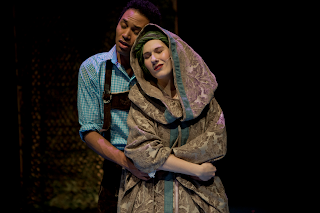An old-fashioned Christmas musical
By Alec Clayton
Published in the Weekly Volcano, Dec. 27, 2018
From left: Edsonya Charles as Ann Collier, Miguel Pineda as B.J. Gibson, Bruce Haasl as Clifton Feddington, Xander Layden as Wally Fergusson, and Christie Murphy-Oldright as Ginger Brooks, photo courtesy Harlequin Productions
Christmas might be over, but Harlequin
Productions continues celebrating the season until New Year’s Eve. For this
year’s holiday show, Harlequin dove deep into their archives to re-stage their
first holiday show, The 1940s Radio Hour. First performed in 1993, this is the
one that inspired the theater’s “Stardust” series, the ever-popular series that
has run for 22 seasons.
It is Dec. 21, 1942, one year into WWII, in the
Algonquin Room of Manhattan’s Astor Hotel where the
radio show “The Mutual Manhattan Variety Cavalcade” is being broadcast. Station
manager and show host Clifton Feddington (Bruce Haasl) is frantic because most
of the performers and band members are late or are not doing what they’re
supposed to do, house manager Pops Bailey (Gerald B. Browning) is running a
bookie operation in the station, featured singer Johnny Cantone (James Dean) is
nowhere to be found, and young and pesky delivery boy, Wally Ferguson (Xander
Layden) is begging him to let him sing on the show.
But the show must go on, and go on
it does, complete with a cavalcade of hit 1930s and ’40s songs including “I Got
a Gal from Kalamazoo,” “Blue Moon,” “Boogie Woogie Bugle Boy,” “I Get a Kick
Out of You,” and Christmas standards including “Jingle Bells,” “I’ll be Home
for Christmas,” “Have Yourself a Merry Little Christmas,” with on air
commercials and a live broadcast of “A Christmas Carol” complete with sound
effects by sound man Lou Cohen (Nathan Rice). Drummer Biff Baker (Andy Garness)
provides a note of sentimentality and patriotism because he is in the Air Force
and it is his last night. Tomorrow he is being shipped overseas to fight in the
war.
Throughout the broadcast there are
endless miscues and other silliness, and star Johnny Cantone gets increasingly
drunk.
The play is lighthearted, shmaltzy
and outdated. The Cantone character is a shame, because drunkenness ceased
being funny a long time ago, and Dean is too good an actor and singer for that
unfortunate role. His voice is clear, deep and resonate — a crooner to equal
the best of the big band era or any other era.
Compensating for the dated script,
the music is outstanding, the commercials are funny, and the radio
play-within-a-radio-play is a joy to behold. Singers Carolyn Willems Van Dijk
as Connie Miller and Christie Murphy-Oldright as Ginger Brooks both have strong
and melodious voices, Miguel Pineda as singer B.J. Gibson is outstanding,
Layden as Wally is the comic hit of the show.
As always, the band is outstanding
with Garness on drums, Rick Jarvela on bass, David Steadman on trumpet, Aaron
Wolff on saxophone, and show Director/Musical Director Aaron Lamb on piano.
1940s Radio Hour, 8 p.m. Thursday-Saturday, 2
p.m. Sunday, through Dec. 31, State Theater, 202 4th Ave. E.,
Olympia, $49 general. $45 senior/military,
$25 student/youth, 360.786.0151,
http://www.harlequinproductions.org/.






